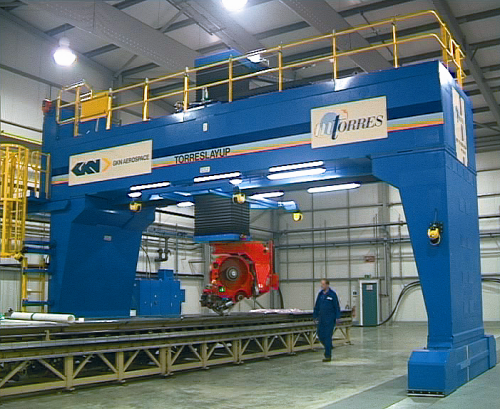
The new A350 XWB (extra wide body) is advertised as being some 53% plastic. Practically all of the A350's visible airframe – wings, fuselage, empennage, nacelles and control surfaces – will be very largely of carbon composite.
The Airbus-designed wing for the A350 wing is a largely composite assembly, though with ribs, internal frames and certain other sub-structures of metal. The wing’s beam strength derives from a central wing box in which two full-span spars form the forward and rear faces of the box. The spars have to be of carbon composite, both for weight saving and so that their coefficient of thermal expansion matches that of the wing’s carbon composite outer envelope.
GKN Aerospace is responsible for the rear spar and assembling it to all the fixed structure that attaches to it, these together comprising the fixed trailing edge (FTE). The composite spar, along with its attached structures, is produced in three 10 m sections that are joined for final checks before the full FTE is disassembled again for transportation to Airbus UK’s wing final assembly facility at Broughton, North Wales, where the complete wing is integrated.
The most substantial, inboard, FTE spar section weighs some 500 kg and includes the tough spar root with composite laminates up to some 25-30 mm thick. The mid-section, which has many attachment points, weighs about 150 kg, while the outboard section weighs 100 kg. Each spar section is produced by laying composite tows onto a large rotating mandrel, the formed part subsequently being autoclave cured under slight pressure. The spar tool is of Inconel metal and the mandrel for laying up spar sections is of carbon, in high modulus grade so that deflection is minimised. The mandrel concept contrasts with traditional metallic tooling philosophies, resulting in lighter, more affordable tooling.
Hexcel’s M21E pre-impregnated carbon/epoxy composite material, as specified by Airbus, is used throughout. Comprising a toughened epoxy resin reinforced with unidirectional carbon fibres, this system confers superior mechanical properties, in particular high impact resistance. Advanced 5-axis automated fibre placement (AFP) machines, purpose-designed and built by M. Torres in Spain, each wind 0.25-inch-wide tapes from up to 16 bobbins via a pulley system onto the rotating mandrel. Machines can be programmed to lay varying thicknesses of material onto the mandrels and can, for instance, build up thickness locally to provide integral pads for rib attachment points along the spar.
“AFP is part of our drive for a high level of automation so that we can efficiently produce wing sections to a consistent high quality while requiring as little manual work as possible,” comments chief engineer Chris Gear. “It will enable us to achieve high production rates so that we can meet our commitments as A350 production builds to a possible 14 aircraft a month. We’re also incorporating robotic drilling and machining and assembly.”
This article is an abstract from the feature Aircraft wing worker for the world, published in the May/June 2010 issue of Reinforced Plastics magazine. Read the complete feature here.
Copyright © 2010 Elsevier Ltd. All rights reserved.





